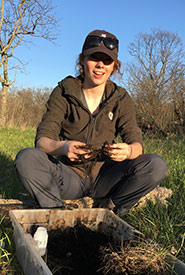You won’t waste your time reading this garbage!
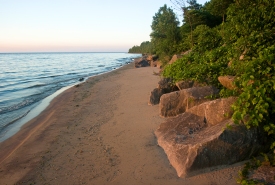
Shore of the Middle Point Woods property, Pelee Island, Ontario (Photo by Sam Brinker, OMNR)
Working as a conservation technician for the Nature Conservancy of Canada (NCC) this summer, I feel lucky to experience the beauty of southwestern Ontario’s Carolinian zone. One of my favourite areas to visit is tranquil Pelee Island, where NCC has acquired over 1,000 acres (404 hectares) of land to ensure that the island’s biodiversity has enough habitat to thrive. Even though the island is isolated from highly urbanized areas, it is still impacted by garbage in many ways.
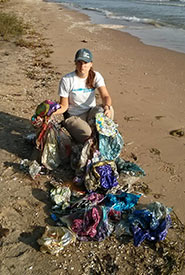
Discarded balloons littered along the shores of Pelee Island (Photo by NCC)
On my first trip to Pelee, I noticed an unsettling trend while walking through the brush. My pockets filled up with old balloons that I found wrapped around the vegetation. It seems Pelee Island is not only a hot spot for wildlife biodiversity, but also for discarded balloons brought over by wind and water! It’s strange to see the aftermath of a balloon being carried away by the wind. Whether being done intentionally or accidentally, most of us have released a balloon into the sky at some point in our lives, myself included. But it’s important to consider what happens once it disappears from view. We forget about its existence as it deflates and falls back down toward the ground.
When most of us think of balloons, we probably think of birthday parties or a thoughtful gesture to or from a friend or loved one. However, balloons can be very hazardous to many species. Birds easily become entangled in their strings, making them unable to fly and preventing them from eating, migrating or avoiding predators.
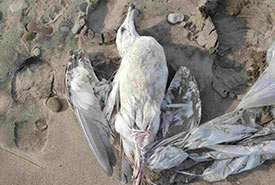
Gull with balloon ribbon wrapped around its feet (Photo by Jason Read)
Often used as nesting material, balloon strings can seriously harm baby birds. When wildlife ingest or become entangled in any other forms of litter, such as mesh or plastics, there can be similar grave consequences for these animals, such as choking, organ failure or starvation. Plastic pollution causes severe problems for wildlife, globally, not only due to its abundance, but from the harmful chemicals that can be found within them. For example, BPA and phthalates affect hatching success and offspring development for many different species, including amphibians, crustaceans and insects.
So, why can’t wildlife adapt to this change in their natural environment?
Environmental change is a natural occurrence. It leads species to physically adapt by evolving over time, adjust through individual fitness and behaviour or disperse in search of new suitable habitat. Currently, the rate of environmental change caused by humans is too rapid to allow most species to adapt by evolution. Dispersal is becoming a task almost too ambitious to attempt due to lack of habitat, especially on an island as small as Pelee. Individuals are then left to adjust to environments that are becoming increasingly challenging to live in.
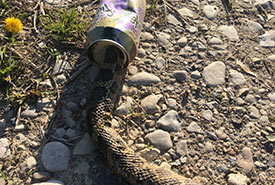
Eastern foxsnake with its head stuck in a pop can (Photo by NCC)
The difficulty with adjusting to new environments is in part due to the instinctive nature of animal behaviour. Back in May, I encountered something that I will never forget while touring a group of high school students through one of NCC’s properties on Pelee Island. One of the students had found a large eastern foxsnake — an endangered species in Ontario ― with its head stuck in a pop can. The snake had recently died, as it was unable to slide its scales backwards against the sharp edges of the can’s opening. I don’t know for certain what led the snake to put its head through the opening, but to a snake an aluminum can is a foreign object that it has not evolved to instinctively avoid. It’s always very upsetting to come across a wild animal that has died from improperly disposed garbage.
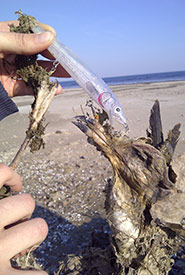
A fishing lure hooked onto a gull (Photo by NCC)
The harmful effects of garbage on wildlife is a growing problem worldwide. Garbage can pose a threat to wildlife, since its breaking-down process takes much longer than organic materials, such as leaf litter. Biodegradable materials that are marketed as environmentally friendly, such as latex balloons, can still take years to degrade. As a result, they can impact many species before they break down.
Even food scraps can create hazards for wildlife. I don’t know how many apple cores and banana peels I mindlessly tossed out of the car window on family road trips as a kid, but you won’t catch me doing it today! Discarded food by the side of the road attracts wildlife toward danger and increases the likelihood of an animal attempting to cross the road, putting it at risk of getting struck by a vehicle.
It is important to think about the lifespan of the everyday materials we use to influence our consumption behaviours. Whether it is a plastic straw from a takeaway drink or an aerosol deodorizer, these items will outlive us by hundreds of years, so it is worth reconsidering our consumption choices. What things do you consider to be true necessities and what serves as mere conveniences that we can live without?
Here are some other general tips to help wildlife:
• Consider volunteering for garbage removal events run by NCC.
• Wash your recyclables and place them in the appropriate bins to avoid them being blown away or carried away by an animal.
• Swap your balloon or lantern release party for a bubble-blowing or native wildflower seed-tossing party.
• Avoid throwing waste onto the road.
• Be a mindful consumer and avoid buying items with excessive packaging.
Feeling ambitious? Try going waste-free for a month!
Ontario’s Conservation Technicians are funded in part by the Government of Canada’s Summer Work Experience program, the Government of Ontario’s Career Ready Fund, the Ontario Trillium Foundation, Bruce Power and Mountain Equipment Co-op.

